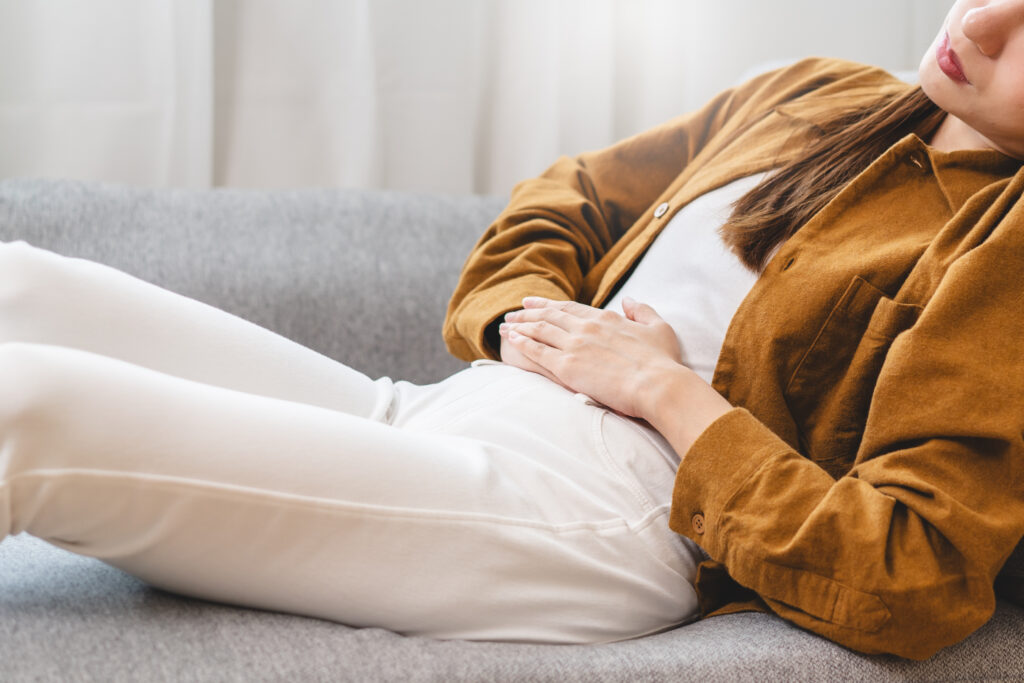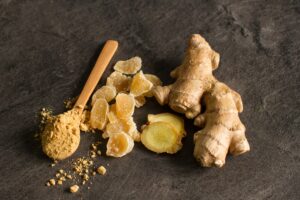Ginger: Natural Relief for Menstrual Cramps
by Clinical Consulting Team
This post was written by our guest author, Alana Campbell, ND, L.Ac
Severe lower abdominal pain during menstruation, or dysmenorrhea, has an estimated prevalence of up to 91% of women.1 Dysmenorrhea can be classified into primary or secondary. Primary dysmenorrhea is pain caused by excessive uterine contractions in the absence of lesions in the pelvis, whereas secondary dysmenorrhea is menstrual pan caused by lesions from endometriosis, chronic pelvic inflammation, uterine fibroids, cervical stenosis, or structural abnormalities.2 This painful and pervasive experience can have major impacts on women’s lives. Pharmaceutical analgesics are the go-to for women who experience this monthly. However, these medications have an estimated failure rate >15% and have adverse effects when used consistently.3 There is a large need for more support for women experiencing dysmenorrhea. Ginger has taken center stage as a treatment for dysmenorrhea that is safe, natural, and effective at reducing pain.
Ginger (Zingiber officinale)
Ginger is a powerful medicinal that belongs in the same family as turmeric, cardamom, and galangal.4 Native originally to southeast Asia, it has been treasured for centuries throughout the world for its culinary and medicinal uses.5 Ginger has a long history as a star of many herbal formulas in traditional Chinese and Ayurvedic medicine. Energetically ginger is warm and stimulating. It has been traditionally used to promote blood circulation, relieve spasms, induce diaphoresis, and stimulate the digestive system.6
How does ginger work?
In traditional Chinese medicine, dysmenorrhea is due to cold, qi, and blood stagnation in the uterus. The therapeutic effect of ginger in the traditional Chinese herbal medicine states that ginger expels cold, warms the channels, relieves stagnation in the abdomen, and stops bleeding.7 It is a primary ingredient in many herbal formulas, such as Wen Jiang Tang (Warm the Uterus Decoction), which have been shown to be effective at reducing pain in (secondary) dysmenorrhea.8
In our modern understanding of primary dysmenorrhea, there are excessive uterine contractions due to increased prostaglandins. Medications (NSAIDs) that interfere with cyclooxygenase-2 (COX-2) activity, and therefore reduce prostaglandins, have been studied to be effective at controlling pain in primary dysmenorrhea.2 The main active ingredients contributing to the analgesic effects of ginger are gingerols and shogaols.2 These constituents have demonstrated effects on the physiology that include the mechanism of action of NSAIDs, while doing so much more. Gingerols and shogaols have been shown to reduce prostaglandin activity through the inhibition of COX-2, NF-κB, and 5-lipoxygenase (5-LOX).2 Shogaols are also agonists for transient receptor potential cation channel subfamily V member 1 (TRPV1). TRPV1 becomes desensitized after continued activation, which leads to a reduction in pain.9
The efficacy of ginger has been demonstrated to be clinically effective in multiple randomized controlled trials! One systematic review, published in 2015, reviewed the current data to date on the efficacy of ginger for treating primary dysmenorrhea. Out of the 29 articles collected, there were 7 randomized controlled trials that met their inclusion criteria. The analysis of these studies confirmed that 750-2000mg of ginger is effective at reducing pain in the first 3-4 days of menstruation. They also found that there was evidence to support that it was as effective as mefenamic acid and ibuprofen. This review also noted that studies have shown safety for doses of ginger up to 2g/kg of body weight.2
In conclusion, ginger is a wonderful option for the many women who experience dysmenorrhea. Not only is it very safe, but it has been shown to be just as effective as some pharmaceutical painkillers.
Here are some suggestions on how to utilize this medicinal:
- Standardized Herbal Extracts at a dose of 750-2000mg as needed for menstrual cramps
- Dried ginger as an ingredient in foods
- A tea of fresh sliced ginger steeped in hot water
- Fresh ginger incorporated into smoothies or vegetables juices
- In traditional Chinese herbal decoctions, prescribed by a knowledgeable herbalist
Sign up for DUTCH emails to get more hormonal health tips in your inbox!
References
- Ju H, Jones M, Mishra G. The prevalence and risk factors of dysmenorrhea. Epidemiol Rev. 2014;36:104-113. doi:10.1093/epirev/mxt009
- Daily JW, Zhang X, Kim DS, Park S. Efficacy of Ginger for Alleviating the Symptoms of Primary Dysmenorrhea: A Systematic Review and Meta-analysis of Randomized Clinical Trials. Pain Med. 2015;16(12):2243-2255. doi:10.1111/pme.12853
- Chen CX, Barrett B, Kwekkeboom KL. Efficacy of Oral Ginger ( Zingiber officinale ) for Dysmenorrhea: A Systematic Review and Meta-Analysis. Evid Based Complement Alternat Med. 2016;2016:1-10. doi:10.1155/2016/6295737
- Zingiberaceae | Description, Genera, & Facts | Britannica. Accessed January 22, 2024. https://www.britannica.com/plant/Zingiberaceae
- Ginger | Description, Plant, Spice, Rhizome, Uses, Flavor, & Facts | Britannica. Published January 21, 2024. Accessed January 22, 2024. https://www.britannica.com/plant/Zingiberaceae
- Wood M. The Earthwise Herbal: A Complete Guide to New World Medicinal Plants. North Atlantic Books; 2009.
- Bensky D, Clavey S, Stoger E. Chinese Herbal Medicine: Materia Medica. 3rd ed. Eastland Press Inc.; 2004.
- Guo Y, Liu FY, Shen Y, et al. Complementary and Alternative Medicine for Dysmenorrhea Caused by Endometriosis: A Review of Utilization and Mechanism. Evid-Based Complement Altern Med ECAM. 2021;2021:6663602. doi:10.1155/2021/6663602
- Iwasaki Y, Morita A, Iwasawa T, et al. A nonpungent component of steamed ginger--[10]-shogaol--increases adrenaline secretion via the activation of TRPV1. Nutr Neurosci. 2006;9(3-4):169-178. doi:10.1080/110284150600955164





